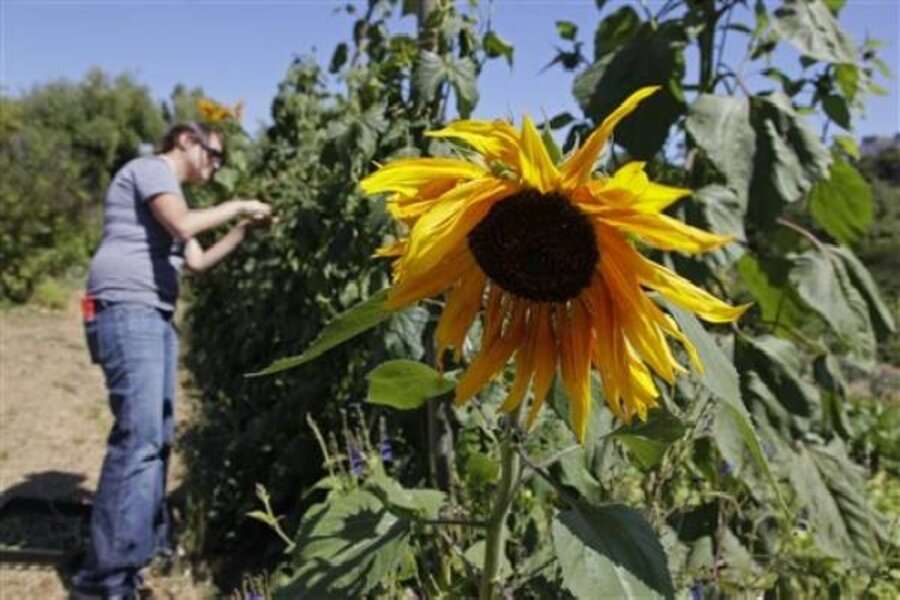From junkyard to community garden
Loading...
| SAN FRANCISCO
Near a San Francisco freeway choked with commuters, Jason Mark shows off rows of strawberries, cucumbers, and loquat trees."It's time to water," he said, checking on green beans growing like vines on stakes.
Mr. Mark helps manage Alemany Farm, a volunteer-run garden that's an example of what the San Francisco mayor wants implemented all over the city: community gardens on vacant and underutilized city-owned lots.
Alemany Farm is on the forefront of a renewed interest in urban farming nationwide, from Michelle Obama's garden on the White House south lawn to the proliferation of backyard chicken coops in New York City.
"I do think there is something like a movement afoot," said Mark, who chronicles environmental trends in the Earth Island Journal and can rattle off the names of urban farms from Milwaukee to Philadelphia.
In the grittiest, grimiest, most unlikely neighborhoods in cities including Los Angeles, Detroit, and Miami, volunteer farmers are growing food that provides not only for those who work the gardens, but also for neighbors, food kitchens, and school lunchrooms.
The US Department of Agriculture says there are thousands of community gardens throughout the country, although no one keeps an exact tally. Localharvest.org, a website about community gardens, lists more than 2,500 in its database.
In 2008, 557 new gardens signed up with LocalHarvest, according to the site. In the first two months of 2009, 300 more joined.
The USDA is calling for more community gardens across the country, with Secretary of Agriculture Tom Vilsack declaring the week of Aug. 23 "National Community Gardening Week."
Vilsack touted the USDA's own backyard garden on the National Mall, which donates produce to DC Central Kitchen, which distributes food to homeless people.
Urban farming isn't new. The American Community Gardening Association held its 30th annual conference this month. Even in the concrete jungle of New York City, residents have been taking over city lots to grow their own food for decades.
But city officials used to fight gardens that sprouted on public property, or pointedly ignore them.
Now, perhaps because of the recession and increased needs in food pantries, city leaders are embracing urban gardens — or farms, as many like to be called.
The trend encompasses backyard chicken coops, now popular all over the country, with many cities, including San Francisco and Fort Collins, Colo., changing laws to allow for small flocks with no roosters.
In San Francisco, Mayor Gavin Newsom has taken the urban farm idea to heart, ordering all city departments to identify unused land – including empty lots, rooftops, and median strips – that could be turned into community gardens.
The main cost to the city is the water provided to the volunteer gardens. Donations from volunteers pay for the seeds and other supplies.
San Francisco currently has about 50 community gardens, Mark says. Alemany Farm was started in the mid-1990s on a 4-1/2-acre lot that was being used as a dumping ground for rusty appliances and broken car parts.
It was shuttered in 2003 when the nonprofit that ran it got into trouble for using taxpayer money to pay its workers to campaign for Newsom during his first mayoral run. Mark and other volunteers started the garden again in 2005.
Nearly 1,000 people have signed up to volunteer. About two dozen different volunteers show up each week to work the grounds, which produce 200 to 250 pounds of produce each week. The garden also donates boxes of produce to about 20 households in the public housing project that stands next door to the lot.
On a recent Wednesday afternoon, several volunteers knocked on doors in the projects asking residents who had requested food boxes what they would like in them. The volunteers then returned to the garden and picked the fruits and vegetables requested.
Alexia Chimenti, a student at San Francisco State University who volunteers at the garden about twice a week and feeds herself with her cut of the produce, brought a bag of broccoli, plums, lemon cucumbers, green beans, and cherry tomatoes to Emma Williams, who uses a wheelchair.
"They keep me healthy," Ms. Williams said as she peered in her bag.
"They keep me healthy, too," Chimenti said.
Editor’s note: For more on gardening, see the Monitor’s main gardening page. Our blog archive. Our RSS feed.
You may also want to visit Gardening With the Monitor on Flickr. If you join the group (it’s free), you can upload your garden photos. Join the discussions and get answers to your gardening questions.





